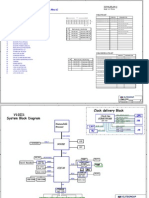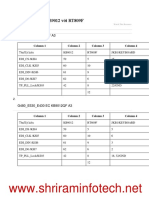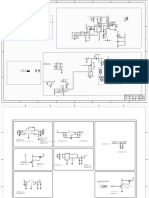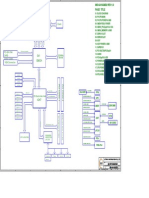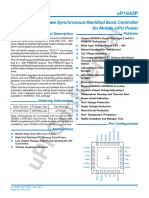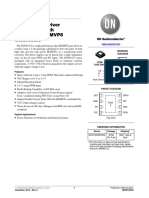uP9011Q DS F0000
uP9011Q DS F0000
Uploaded by
Blue StacksCopyright:
Available Formats
uP9011Q DS F0000
uP9011Q DS F0000
Uploaded by
Blue StacksOriginal Title
Copyright
Available Formats
Share this document
Did you find this document useful?
Is this content inappropriate?
Copyright:
Available Formats
uP9011Q DS F0000
uP9011Q DS F0000
Uploaded by
Blue StacksCopyright:
Available Formats
uP9011Q
Complete DDR3/ DDR4 Memory Power Solution Converter
General Description Features
The uP9011Q is a high performance synchronous buck Synchronous Buck Converter (VDDQ)
converter with 1.5A source/sink LDO for memory system
Wide Input Voltage Range from 4.5V to 26V
power. It also provides a buffered low noise reference
VTTREF. The uP9011Q has wide operation range from 4.5V Fast Load Transient Response
to 26V for input voltage and 0.75V to 3.3V for memory Output Current up to 8A
output voltage.
RCOTTM Control Topology
The synchronous buck of the uP9011Q adopts uPI
Soft-Off in S4/S5 States
proprietary robust constant on-time (RCOT TM) PWM
scheme that features easy-to-use, low external component Fixed 1.5V (DDR3), 1.8V (DDR2) Output or
count, fast transient response and quasi-constant frequency Adjustable from 0.75V to 3.3V
operation over the operation range. POK, OVP, UVP and Thermal Shutdown
The 1.5A source/sink LDO for VTT has fast transient LDO (VTT)
response, requiring only two 10uF of ceramic output
capacitors. In addition, the LDO supply input is available 1.5A Source/Sink Capability
externally to significantly reduce the total power losses. Requires Only Two 10uF Ceramic Output
The uP9011Q supports all the sleep state controls, in S3 Capacitors
state (suspend to RAM) VTT is disable and in S4/S5 Disable in S3 and Soft-Off in S4/S5
(suspend to disk) VDDQ, VTT and VTTREF are soft off.
Thermal Shutdown
The uP9011Q has complete functions including under
voltage protection, over current protection, over voltage + 20mV Accuracy
protection, power-up sequencing, power OK output, and Reference Voltage (VTTREF)
thermal shutdown. The uP9011Q is available in WQFN4x4-
+ 20mV Accuracy
32L package.
Low Noise + 10mA Output
Applications
RoHS Compliant and Halogen Free
Desktop PCs, Notebooks, and Workstations
Microprocessor and Chipset Supplies
Pin Configuration
DDR3/DDR3L/DDR4 Memory Power Supplies
20 PHASE
19 PHASE
18 PHASE
17 PHASE
SSTL-2 SSTL-18 and HSTL Bus Termination
24 VIN
23 VIN
22 VIN
21 VIN
Ordering Information
PHASE 25 16 PGND
Order Number Package Type Top Marking NC 26 Exposed 15 PGND
Pad II
BOOT 27 14 PGND
uP9011QQMI WQFN4x4-32L uP9011Q (VIN)
VTTIN 28 Exposed Pad III 13 PGND
Note: VTT 29 (PHASE) 12 PGND
(1) Please check the sample/production availability with VTTGND 30 Exposed 11 PGND
uPI representatives. VTTSNS 31
Pad I
10 CS
(VTTGND)
(2) uPI products are compatible with the current IPC/
GND 32 9 VCC
JEDEC J-STD-020 requirement. They are halogen-free,
RoHS compliant and 100% matte tin (Sn) plating that are
1
2
3
4
5
6
7
8
suitable for use in SnPb or Pb-free soldering processes.
FB
VDDQ
VTTREF
VTTGND
TON
S3
S5
POK
uP9011Q-DS-F0000, Dec. 2015 1
www.upi-semi.com
uP9011Q
Typical Application Circuit
VIN
TON VIN
POK POK BOOT
PHASE VVDDQ
5V VCC
PGND
CS
S3 S3 FB
S5 S5
VTTREF VDDQ
VTTIN
GND VTT VVTT
VTTGND VTTSNS
Adjustable Output Voltage Regulator for VDDQ
VIN
TON VIN
POK POK BOOT
VVDDQ
PHASE
1.8V/1.5V
5V VCC
PGND
CS
To 5V for DDRII
S3 S3 FB
To GND for DDRIII
S5 S5
VTTREF VDDQ
VTTIN
VVTT
GND VTT
0.9V/0.75V
VTTGND VTTSNS
Fixed Output Voltage Regulator for VDDQ
2 uP9011Q-DS-F0000, Dec. 2015
www.upi-semi.com
uP9011Q
Functional Pin Description
Pin No. Pin Name Pin Function
Buffered Reference Output. Bypass this pin with a 33nF ceramic capacitor to GND. This
1 VTTREF
pin is capable of sourcing up to 10mA current for external loads.
Reference Input for VTT and VTTREF. Connect this pin to the VDDQ output. This pin is
the di scharge current si nki ng termi nal of V D D Q output i n S 4/S 5 states. When V D D Q
2 VD D Q
regulator is in fixed output configuration (FB pin is tied to VCC or GND), this pin is the output
voltage feedback input.
VD D Q Voltage Feedback Input. Thi s pi n i s the i nverti ng i nput of the error ampli fi er. A
resistor divider from output to GND is used to set the regulator output voltage. For fixed
3 FB
output voltage application, connect this pin to VCC for DDR2 power supply, or connect this
pin to GND for DDR3 power supply.
4,30 VTTGND Pow er Ground for the VTT LDO.
S 3 S ig n al In p u t. C onnect thi s pi n to the computer system's S LP _S 3 si gnal. Thi s pi n
5 S3 companied with S5 switches the IC's operating state from active (S0, S1/S2) to S3 and
S4/S5 sleep states.
S 5 S ig n al In p u t. C onnect thi s pi n to the computer system's S LP _S 5 si gnal. Thi s pi n
6 S5 companied with S3 switches the IC's operating state from active (S0, S1/S2) to S3 and
S4/S5 sleep states.
On-Time Setting Pin. Connect a resistor from this pin to VIN to set the on-time for the upper
7 TON
MOSFET.
Pow er OK Indication. POK is the open-drain architecture that indicates the output voltage
is ready or not. This pin is set to high impedance when the output voltage is within regulation
8 POK
and the soft-start ends. POK is pulled low immediately when either output is in soft-start,
standby, shutdown or fault protection.
5V Pow er Supply Input. This pin provides power for internal circuit. Bypass this pin with
9 VC C
a 1uF ceramic capacitor to GND.
Current Limit Threshold Setting. Connect this pin through the setting resistor to VCC for
10 CS
inductor current limit threshold setting.
Pow er Ground. This pin is dedicated for lower MOSFET gate driver and should be directly
11~16 PGND
connected to the source of the lower MOSFET with an isolated path.
Sw itch Node. This pin is used as the sink for the upper MOSFET gate driver. This pin is
17~20, a lso mo ni to re d b y the sho o t-thro ug h p ro te cti o n ci rcui try to d e te rmi ne whe n the up p
PHASE
25 MOSFET has turned off. Connect this pin to the source of the upper MOSFET and the drain
of the lower MOSFET.
21~24 VIN Supply Input. Input voltage that supplies current to the output voltage.
26 NC Not Internally Connected.
Bootstrap Supply for the Floating Upper MOSFET Gate Driver. The bootstrap capacitor
27 BOOT provides the charge to turn on the upper MOSFET. Connect this bootstrap capacitor between
BOOT pin and the PHASE pin to form a bootstrap circuit.
Input for the VTT LDO. This is the drain input to the power device that supplies current to
28 VTTIN
the VTT pin.
Output for the VTT LDO. This pin is the output of VTT. Typical value of two 10uF ceramic
29 VTT capacitors is recommended to reduce the effects of current transients on VOUT. A pull low
resistance exists when the device is disabled.
uP9011Q-DS-F0000, Dec. 2015 3
www.upi-semi.com
uP9011Q
Functional Pin Description
Pin No. Pin Name Pin Function
VTT LDO Output Voltage Sense. Connect this pin to the VTT LDO output capacitors for
31 VTTSNS
VTT output voltage sensing.
32 GND Signal Ground for the IC. All voltage levels are measured with respect to this pin.
Exposed Pad I
Pow er Ground for the VTT LDO.
(VTTGND)
Exposed Pad II
Supply Input. Input voltage that supplies current to the output voltage.
(VIN)
Sw itch Node. This pin is used as the sink for the upper MOSFET gate driver. This pin is
Exposed Pad III also monitored by the shoot-through protection circuitry to determine when the upper MOSFET
(PHASE) has turned off. Connect this pin to the source of the upper MOSFET and the drain of the lower
MOSFET.
Functional Block Diagram
S3 POR VCC
Output Enable and
S5 Discharge Enable
POK
VPOK
VOV
VTTREF OV
VIN
VTTIN VUV
UV
BOOT
VTT
Control Logic PHASE
VTTGND
PGND
VTTSNS
VDDQ
Zero Cross
Detection
Current
Ramp Limit CS
Soft-Start
Generator
On-time
FB
Calculator
GND
Reference
Voltage
TON
4 uP9011Q-DS-F0000, Dec. 2015
www.upi-semi.com
uP9011Q
Functional Description
The uP9011Q is a high performance synchronous buck VIN
converter with 1.5A source/sink VTT LDO for memory VIN
system power. It also provides the buffered low noise
BOOT
reference with 10mA capability.
The buck converter adopts RCOTTM PWM scheme that PHASE VVDDQ
features easy-to-use, low external component count, fast
PGND
transient response and quasi-constant frequency operation
over the operation range.
RFB1
The 1.5A source/sink VTT LDO has fast transient response FB
that only requires two 10uF of ceramic output capacitors. RFB2
The reference voltage tracks VDDQ/2 within 1% of VDDQ.
The VTT tracks VTTREF within 20mV at no load condition VDDQ
and within 40mV over all load conditions.
Figure 1. VDDQ Output Voltage Setting
The uP9011Q supports all the sleep state controls, and
On-Time Setting
also has complete functions including over current
The uP9011Q adopts a compensated constant-on-time
protection, over voltage protection, thermal shutdown,
control scheme. A resistor RTON connected to TON pin
power-up sequencing, power OK output, and thermal
shutdown. The uP9011Q is available in space-saving programs the constant on time according to equation:
WQFN4x4-32L package. 3.8 × 10 −12 × VDDQ × R TON
TON =
Output Voltage Selection VIN − 0.5 V
As shown in Table 1, uP9011Q can support DDR2, DDR3, where RTON is in kΩ, VIN is the supply input voltage and
DDR3L, DDR4 power supply or adjustable output voltage VDDQ is the sensed output voltage.
by connecting resistor divider to the FB pin.
900
Table 1. Output Voltage Selection
800
FB VTTREF
VD D Q Application
Switching Frequency (kHz)
Connection and VTT 700
VC C 1.8 V VD D Q / 2 DDR2 600
GND 1.5 V VD D Q / 2 DDR3 500
DDR3L, DDR4
Resistor 400
Adjustable VD D Q / 2 0.75V < VVDDQ
Divider
< 3.3V
300
The uP9011Q can adjust output voltage by connecting a 200
resistive voltage divider between VDDQ and GND as shown 300 400 500 600 700 800 900 1000
in Figure 1. Choose RFB2 to be approximately 10kΩ and RTON (kohm)
solve RFB1 using the equation as below: Figure 2. Switching Frequency vs. RTON
Soft Start and POK
R FB1
VDDQ = VREF × (1 + ) The power sequence of uP9011Q is shown in Figure 3.
R FB2
After S5 is set high, VDDQ begins to ramp up after a period
where VREF is 0.75V (typ.). of delay time T1. Then the output voltage begins to soft
start to 90% of the target voltage with time interval T2 as
the end of soft start. The controller then checks the output
voltage after a period of delay time T3. If the output voltage
is in regulation, POK will be set to high impedance to
complete the power on sequence. The POK is an open-
drain output. When fault protection (OVP/UVP/thermal
shutdown) is triggered during operation, the POK will be
pulled low.
uP9011Q-DS-F0000, Dec. 2015 5
www.upi-semi.com
uP9011Q
Functional Description
will keep upper MOSFET off even the voltage loop
commands it to turn on. Converter will latch off if CS pin
VS5
is open during VCC power on or enable.
90%
The output voltage will decrease if the load continuously
VVDDQ/VVTTREF
demands more current than current limit level. Further
increase in load current higher than the current limit level
VPOK will eventually let VVDDQ decrease to trip UVP to shut down
T1 T2 T3 the uP9011Q.
The current limit threshold is set by connecting a resistor
Figure 3. VDDQ Soft Start and POK Timing from CS to VCC. The CS pin will sink a 10uA current
VDDQ Light Load Operation source and create a voltage drop across RCS as the VOCSET.
The uP9011Q automatically reduces switching frequency VOCSET = 10uA x RCS.
at light load to maintain high efficiency. As the output current
When the voltage drop across the lower MOSFET equals
decreases from heavy-load condition, the inductor current
the voltage across the setting resistor, the current limit
will also be reduced, and eventually comes to the point
will be activated.
that its valley touches zero current, which is the boundary
between continuous conduction and discontinuous The current limit level is calculated as:
conduction modes. By emulating the behavior of diodes,
VOCSET IRIPPlE
the lower MOSFET allows only partial of negative current ILIM = +
when the inductor freewheeling current reaches negative. RDS( ON) 2
As the load current is further decreased, it takes longer where IRIPPLE is the peak-to-peak inductor ripple current at
time to discharge the output capacitor to the level than steady state.
requires the next ON cycle.
Over Voltage/Under Voltage Protection
Outputs Control by S3, S5
The uP9011Q monitors FB voltage to detect overvoltage
The uP9011Q provides the output management for the sleep- and undervoltage condition of VDDQ output.
mode signals such as SLP_S3 and SLP_S5 in the
notebook PC system by monitoring S3, S5 status, the When the FB voltage becomes higher than 115% of the
output control table is as shown in Table 2 below. target voltage, the OVP is triggered. Then, upper
MOSFET is off and lower MOSFET is on. When the FB
Table 2. S0, S3 and S5 State voltage is lower than 70% of the target voltage, the UVP
VDDQSN- is triggered after 30us fault detection. Then, upper
State S3 S5 V TTR E F V TT
S MOSFET and lower MOSFET are latched off. This function
S0 High High On On On is enabled 5ms after S5 go high to ensure startup.
Off VCC UVLO
S3 Low High On On
(discharge)
The VCC has under voltage lockout protection (UVLO).
S4 Off Off Off When the VCC voltage is lower than UVLO threshold
Low Low
S5 (discharge) (discharge) (discharge) voltage, all functions are turned off. This is non-latch
protection.
Ouput Discharge Control
Thermal Protection
The uP9011Q is in non-tracking discharge mode when it
enters S4/S5 state. In this non-tracking discharge mode, The uP9011Q monitors the temperature of itself. If the
the uP9011Q discharges the VDDQ and VTT outputs temperature exceeds typical 150OC, the uP9011Q will be
through the internal MOSFETs with 15Ω RDS(on) which are turned off. This is non-latch protection.
connected from VDDQ to GND, and from VTT to VTTGND,
respectively.
Output Current Limit
The synchronous buck VDDQ monitors the inductor valley
current by lower MOSFET RDS(ON) when it turns on. The
over current limit is triggered once the sensing current level
is higher than VOCSET. When triggered, the over current limit
6 uP9011Q-DS-F0000, Dec. 2015
www.upi-semi.com
uP9011Q
Absolute Maximum Rating
(Note 1)
VCC to GND ----------------------------------------------------------------------------------------------------------- -0.3V to +6V
BOOT to PHASE ------------------------------------------------------------------------------------------------------------- -0.3V to +6V
PHASE to GND
DC ------------------------------------------------------------------------------------------------------------------------- -0.3V to +30V
<50ns ------------------------------------------------------------------------------------------------------------------------ -5V to +30V
Other Pins ----------------------------------------------------------------------------------------------------------------------- -0.3V to +6V
Storage Temperature Range ----------------------------------------------------------------------------------- -65OC to +150OC
Junction Temperature ------------------------------------------------------------------------------------------------------- 150OC
Lead Temperature Range(Soldering 10sec) ------------------------------------------------------------------------------------------- 260OC
ESD Rating (Note 2)
HBM(Human Body Mode)---------------------------------------------------------------------------------------------------------------2KV
MM(Mechine Mode)-----------------------------------------------------------------------------------------------------------------------200V
Thermal Information
Package Thermal Resistance (Note 3)
WQFN4x4-32L θJA, controller -------------------------------------------------------------------------------------------- 55OC/W
WQFN4x4-32L θJA, HS -------------------------------------------------------------------------------------------------- 45OC/W
WQFN4x4-32L θJA, LS -------------------------------------------------------------------------------------------------- 39OC/W
WQFN4x4-32L θJC, controller -------------------------------------------------------------------------------------------- 21OC/W
WQFN4x4-32L θJC, HS -------------------------------------------------------------------------------------------------- 12OC/W
WQFN4x4-32L θJC, LS -------------------------------------------------------------------------------------------------- 7OC/W
Power Dissipation, PD @ TA = 25°C
WQFN4x4-32L PD, controller ---------------------------------------------------------------------------------------------------- 1.81W
WQFN4x4-32L PD, HS -------------------------------------------------------------------------------------------------------- 2.22W
WQFN4x4-32L PD, LS -------------------------------------------------------------------------------------------------------- 2.56W
Recommended Operation Conditions
(Note 4)
Supply Input Voltage, VIN ------------------------------------------------------------------------------------------------------- 4.5V to 26V
Control Voltage, VCC ----------------------------------------------------------------------------------------------- 4.5V to 5.5V
Operating Junction Temperature Range -------------------------------------------------------------------- -40OC to +125OC
Operating Ambient Temperature Range -------------------------------------------------------------------------------- -40OC to +85OC
Note 1. Stresses listed as the above Absolute Maximum Ratings may cause permanent damage to the device.
These are for stress ratings. Functional operation of the device at these or any other conditions beyond
those indicated in the operational sections of the specifications is not implied. Exposure to absolute
maximum rating conditions for extended periods may remain possibility to affect device reliability.
Note 2. Devices are ESD sensitive. Handling precaution recommended.
Note 3. θJA is measured in the natural convection at TA = 25°C on a high effective thermal conductivity test board of
JEDEC 51-7 thermal measurement standard.
Note 4. The device is not guaranteed to function outside its operating conditions.
Note 5. Guarantee by design.
uP9011Q-DS-F0000, Dec. 2015 7
www.upi-semi.com
uP9011Q
Electrical Characteristics
(VIN = 15V, VVCC = 5V, VTTIN is connected to VDDQ output, TA = +25OC unless otherwise specified.)
Parameter Symbol Test Conditions Min Typ Max Unit
Supply Current
Supply current, VS3 = 0V, VS5 = 5V, force
-- 470 1000
VCC Current IVCC+PVCC FB above regulation level (no switching). uA
Shutdown current, VS3 = VS5 = 0V -- 1 10
Standby current, VS3 = 0V, VS5 = 5V. No
-- 0.1 10
load at VTT pin
VTTIN Current IVTTIN Shutdown current, VS3 = VS5 = 0V -- 0.1 1 uA
Bias current, VS3 = VS5 = 5V, no load at
-- 1 --
VTT pin.
Operating current, RTON = 1MΩ -- 15 --
TON Current ITON uA
Shutdown current, VS3 = VS5 = 0V -- 0.1 5
Reference Voltage
VVCC = 4.5V to 5.5V 0.742 0.75 0.758
FB Reference Voltage VREF Connect FB pin to VCC. -- 1.8 -- V
Connect FB pin to GND. -- 1.5 --
FB Input Bias Current IFB VFB = 0.75V. -1 0.1 1 uA
VTTREF Output
Connect FB pin to VCC. -- 0.9 --
VTTREF Output Voltage VVTTREF V
Connect FB pin to GND. -- 0.75 --
VTTREF Output Voltage VVDDQ = VVTTIN = 1.8V , | IVTTREF | <10mA -18 -- 18
VVTTREFTO mV
Tolerance VVDDQ = VVTTIN = 1.5V , | IVTTREF | <10mA -15 -- 15
IVTTREFOCLSR-
VTTREF Source Current Limit VVTTREF = 0V 10 -- -- mA
C
VTT Output
VVDDQ = VVTTIN = 1.2V/ 1.35V /1.5V/ 1.8V,
-20 -- 20
IVTT = 0A
VVDDQ = VVTTIN = 1.2V/ 1.35V/ 1.5V /1.8V,
VTT Output Voltage Tolerance VVTTTO -30 -- 30 mV
| IVTT | < 1A
VVDDQ = VVTTIN = 1.2V/ 1.35V, | IVTT | < 1.2A -40 -- 40
VVDDQ = VVTTIN = 1.5V/ 1.8V, | IVTT | < 1.5A -40 -- 40
VVTT = (VVDDQ/ 2) x 0.95 1.5 -- --
VTT Source Current Limit IVTTTOCLSRC A
VVTT = 0V -- 1.3 --
VVTT = (VVDDQ/ 2) x 1.05 1.5 -- --
VTT Sink Current Limit IVTTTOCLSNK A
VVTT = VVDDQ -- 1.3 --
VTTSNS Leakage Current IVTTSNSLK Sink current = 1mA -1 -- 1 uA
VTT Discharge Current IVTTDis VS3 = VS5 = 0V, VVDDQ = 0V, VVTT = 0.5V 10 30 -- mA
8 uP9011Q-DS-F0000, Dec. 2015
www.upi-semi.com
uP9011Q
Electrical Characteristics
Parameter Symbol Test Conditions Min Typ Max Unit
VD D Q
VDDQ Input Resistance RVDDQ -- 100 -- kΩ
VDDQ Discharge Resistance IVDDQDis V S 5 = 0V -- 15 -- Ω
On Time
On-Time TON RTON = 1MΩ , VVDDQ = 1.25V 267 334 401 ns
Minimum On-Time TONMIN -- 80 -- ns
Minimum Off-Time TOFFMIN 250 400 550 ns
Pow er OK
Measured at FB, with respect to
87 90 93
POK Rising Threshold VTHPOKH reference voltage. %
Hysteresis -- 5 --
From FB forced below POK falling
POK Propagation Delay TPOK -- 2.5 -- us
threshold to POK go low.
POK Leakage Current ILK_POK High state, POK = 5V -- -- 1 uA
POK Output Low Voltage VPOK_L Sink current = 1mA -- -- 0.4 V
Logic Input Threshold
High Level Input Voltage VIH S3, S5 High 2 -- -- V
Low Level Input Voltage VIL S 3, S 5 Low -- -- 0.8 V
Logic Input Leakage Current VINLEAK S3, S5 = 5V/0V -1 -- 1 uA
Internal Bootstrap Sw itch
Internal Boost Charging Switch
RBOOT VCC to BOOT, IBOOT = 5mA -- -- 80 Ω
On-Resistance
Pow er Sw itches
Upper Switch Resistance RUG,DSON -- 21.5 26 mΩ
Lower Switch Resistance RLG,DSON -- 9 11 mΩ
Protection: Current Limit
CS Sink Current ICS VCS > 4.5V 9 10 11 uA
ppm/-
CS Current Temp. Coefficient TCICS On the basis of 25OC (Note 5) -- 4700 -- O
C
OCP Comparator Offset VOCLoff GND - VPHASE, RCS = 5kΩ -15 -- 15 mV
Zero Current Threshold VZC GND - VPHASE -5 -- 10 mV
uP9011Q-DS-F0000, Dec. 2015 9
www.upi-semi.com
uP9011Q
Electrical Characteristics
Parameter Symbol Test Conditions Min Typ Max Unit
Protection: UVP & OVP
Measured at FB, with respect to
OVP Trip Threshold VOVP 110 115 120 %
reference voltage.
OVP Propagation Delay TOVPDEL Force FB above OVP trip threshold. -- 20 -- us
Measured at FB, with respect to
UVP Trip Threshold VUVP 60 70 80 %
reference voltage.
UVP Propagation Delay TUVPDEL Force FB below UVP trip threshold. -- 30 -- us
UVP Enable Delay TUVPEN From S5 signal go high -- 2 -- ms
Protection: UVLO
Rising edge 3.9 4.2 4.5
VCC UVLO Threshold VUVLO V
Hysteresis -- 0.12 --
Protection: Thermal Shutdow n
Shutdown temperature -- 150 --
O
Thermal Shutdown Threshold TSDN C
Hysteresis -- 20 --
10 uP9011Q-DS-F0000, Dec. 2015
www.upi-semi.com
uP9011Q
Typical Operation Characteristics
Power On from S3, S5 with Light Load Power On from S3, S5 with Heavy Load
S3,S5 5V/Div S3,S5 5V/Div
VDDQ 1V/Div VDDQ 1V/Div
VTT 500mV/Div VTT 500mV/Div
POK 5V/Div POK 5V/Div
Time: 100us/Div Time: 100us/Div
VIN = 6V, VDDQ = 1.35V, VTT = 0.675V, VIN = 6V, VDDQ = 1.35V, VTT = 0.675V,
VDDQ/VTT Load = no load VDDQ/VTT Load = 0.165Ω/0.5Ω
Power Off from S3, S5 with Light Load Power Off from S3, S5 with Heavy Load
Non Tracking Discharge Non Tracking Discharge
S3,S5 5V/Div S3,S5 5V/Div
VDDQ 1V/Div
VDDQ 1V/Div
VTT 500mV/Div VTT 500mV/Div
POK 5V/Div POK 5V/Div
Time: 200us/Div Time: 20us/Div
VIN = 6V, VDDQ = 1.35V, VTT = 0.675V, VIN = 6V, VDDQ = 1.35V, VTT = 0.675V,
VDDQ/VTT Load = 10Ω/4.7Ω VDDQ/VTT Load = 0.165Ω/0.5Ω
Transient Response Transient Response
(Load Applied: 0.8A to 7.2A) (Load Released: 7.2A to 0.8A)
VDDQ 50mV/Div VDDQ 50mV/Div
PHASE 5V/Div PHASE 5V/Div
IOUT 5A/Div IOUT 5A/Div
Time: 10us/Div Time: 10us/Div
VIN = 6V, VDDQ = 1.35V, L= 0.68uF, VIN = 6V, VDDQ = 1.35V, L= 0.68uF,
COUT = MLCC (22uFx5) COUT = MLCC (22uFx5)
uP9011Q-DS-F0000, Dec. 2015 11
www.upi-semi.com
uP9011Q
Typical Operation Characteristics
Transient Response Transient Response
(Load Applied: 0.8A to 7.2A) (Load Released: 7.2A to 0.8A)
VDDQ 50mV/Div VDDQ 50mV/Div
PHASE 10V/Div PHASE 10V/Div
IOUT 5A/Div IOUT 5A/Div
Time: 10us/Div Time: 10us/Div
VIN = 19V, VDDQ = 1.35V, L= 0.68uF, VIN = 19V, VDDQ = 1.35V, L= 0.68uF,
COUT = MLCC (22uFx5) COUT = MLCC (22uFx5)
OCP & UVP OVP
VDDQ 1V/Div
PHASE 5V/Div
VDDQ 500mV/Div
IL 5A/Div PHASE 5V/Div
POK 5V/Div POK 5V/Div
Time: 10us/Div Time: 20us/Div
VIN = 6V, VDDQ = 1.35V, L= 0.68uF, VIN = 6V, VDDQ = 1.35V, VDDQ Load = 1.5A
COUT = MLCC (22uFx5)
Output Control by S3, S5 VDDQ Line Regulation
1.38
1.37
S3 5V/Div
IOUT = 0A
S5 5V/Div 1.36
VDDQ(V)
VDDQ 1V/Div 1.35
IOUT = 8A
1.34
VTT 1V/Div
1.33
0 5 10 15 20 25 30
Time: 4ms/Div Vin (V)
VIN = 6V, VDDQ = 1.35V, VTT = 0.675V, VCC = 5V
VDDQ/VTT Load = 20Ω/10Ω
12 uP9011Q-DS-F0000, Dec. 2015
www.upi-semi.com
uP9011Q
Application Information
PCB Layout Considerations Place the output capacitor for VTT should close to the
pin with short and wide trace to avoid additional ESR and/
High speed switching and relatively large peak currents in
or ESL of the trace.
a synchronous-rectified buck converter make the PCB layout
a very important part of design. Fast current switching from Connect VTT to the positive of VTT output capacitors
one device to another in a synchronous-rectified buck with a separate trace.
converter causes voltage spikes across the interconnecting VDDQ can be connected separately from VTTIN.
impedances and parasitic circuit elements. The voltage Remember that this sensing potential is the reference
spikes can degrade efficiency and radiate noise that result voltage of VTTREF. Avoid any noise generative lines.
in overvoltage stress on devices. Careful component
Negative node of VTT output capacitor(s) and
placement layout and printed circuit board design minimizes
VTTREF capacitor should be tied together by avoiding
the voltage spikes induced in the converter.
common impedance to the high current path of the VTT
Follow the layout guidelines for optimal performance of source/sink current.
uP9011Q. GND (Signal GND) pin node represents the reference
Keep the PCB trace PHASE node as short and wide potential for VTTREF and VTT outputs. Connect GND to
as possible. negative nodes of VTT capacitor(s), VTTREF capacitor
Add a sunbber circuit between PHASE and PGND to and VDDQ capacitor(s) with care to avoid additional ESR
eliminate the high frequency voltage spike at PHASE node. and/or ESL. GND and PGND (power ground) should be
connected together at a single point.
Keep sensitive analog circuits such as VDDQ,
VTTSNS and CS away from high voltage switching node
such as PHASE.
Connect VDDQ output to VTTIN with short and wide
trace. If other power source is used as VTTIN, a bypass
input capacitor should be placed as close to VTTIN as
possible.
uP9011Q-DS-F0000, Dec. 2015 13
www.upi-semi.com
uP9011Q
Package Information
WQFN4x4-32L
0.00 - 0.10 0.20 - 0.35
0.96 - 1.16
0.10 - 0.20 0.20 - 0.35
0.25 - 0.35
0.20 - 0.35
2.15 - 2.25
3.90 - 4.10
3.90 - 4.10 0.25 - 0.35
0.20 - 0.35 1.01 - 1.21
0.40 BSC 0.20 - 0.35
Pin 1 mark
Bottom View - Exposed Pad
0.70 - 0.80
0.0 - 0.05 0.20 REF
Note
1.Package Outline Unit Description:
BSC: Basic. Represents theoretical exact dimension or dimension target
MIN: Minimum dimension specified.
MAX: Maximum dimension specified.
REF: Reference. Represents dimension for reference use only. This value is not a device specification.
TYP. Typical. Provided as a general value. This value is not a device specification.
2.Dimensions in Millimeters.
3.Drawing not to scale.
4.These dimensions do not include mold flash or protrusions. Mold flash or protrusions shall not exceed 0.15mm.
14 uP9011Q-DS-F0000, Dec. 2015
www.upi-semi.com
uP9011Q
Important Notice
uPI and its subsidiaries reserve the right to make corrections, modifications, enhancements, improvements, and other
changes to its products and services at any time and to discontinue any product or service without notice. Customers
should obtain the latest relevant information before placing orders and should verify that such information is current and
complete.
uPI products are sold subject to the terms and conditions of sale supplied at the time of order acknowledgment.
However, no responsibility is assumed by uPI or its subsidiaries for its use or application of any product or circuit; nor
for any infringements of patents or other rights of third parties which may result from its use or application, including but
not limited to any consequential or incidental damages. No uPI components are designed, intended or authorized for
use in military, aerospace, automotive applications nor in systems for surgical implantation or life-sustaining. No license
is granted by implication or otherwise under any patent or patent rights of uPI or its subsidiaries.
COPYRIGHT (C) 2013, UPI SEMICONDUCTOR CORP.
uPI Semiconductor Corp. uPI Semiconductor Corp.
Headquarter Sales Branch Office
9F.,No.5, Taiyuan 1st St. Zhubei City, 12F-5, No. 408, Ruiguang Rd. Neihu District,
Hsinchu Taiwan, R.O.C. Taipei Taiwan, R.O.C.
TEL : 886.3.560.1666 FAX : 886.3.560.1888 TEL : 886.2.8751.2062 FAX : 886.2.8751.5064
uP9011Q-DS-F0000, Dec. 2015 15
www.upi-semi.com
You might also like
- V320BJ6-Q01ApprovalSpec V2.0 20160712 CommonDocument33 pagesV320BJ6-Q01ApprovalSpec V2.0 20160712 CommonbosryanbroNo ratings yet
- LG Eax64905301 Led TV Power SupplyDocument2 pagesLG Eax64905301 Led TV Power Supplyies83775% (8)
- Ncp81205a DDocument28 pagesNcp81205a DBlue Stacks100% (1)
- Samsung UA32N4300AK Chassis UAV81Document55 pagesSamsung UA32N4300AK Chassis UAV81Francisco NavarroNo ratings yet
- Jeep Style Twin Bed Assembly IntructionsDocument14 pagesJeep Style Twin Bed Assembly IntructionsHumberto AndujarNo ratings yet
- NT50262MQG Nihon Dempa Kogyo Co LTD Product DetailsDocument3 pagesNT50262MQG Nihon Dempa Kogyo Co LTD Product DetailskevynNo ratings yet
- Schematic Asus k43sd Rev 2.2Document3 pagesSchematic Asus k43sd Rev 2.2JoungAmbon43% (7)
- Quick Installation Guide LVDS VGA Rev1.01Document2 pagesQuick Installation Guide LVDS VGA Rev1.01Emmanuel VenturaNo ratings yet
- Gambit MLK MT - A00 - 20180202 - 01Document107 pagesGambit MLK MT - A00 - 20180202 - 01Tin Học Chí CôngNo ratings yet
- NT71710MFG 000Document1 pageNT71710MFG 000Tahir Hussain50% (4)
- Ali-M3329 819 DatasheetDocument1 pageAli-M3329 819 Datasheetmarcoslemos100043% (14)
- Panel Boe Hv320wxc-100 0 (DS)Document27 pagesPanel Boe Hv320wxc-100 0 (DS)Milorad PajovicNo ratings yet
- Title: HV430FHB-N10 Product Specification: 拟制 审核 批准 DateDocument29 pagesTitle: HV430FHB-N10 Product Specification: 拟制 审核 批准 DateGeovanny Jose Sanjuan Bustamante100% (1)
- WTR2965 PDFDocument1 pageWTR2965 PDFPranay Joshi50% (2)
- 30GXR170-640 Compressor - Carrier ChillerDocument34 pages30GXR170-640 Compressor - Carrier ChillercafonchoNo ratings yet
- Huawei ODN PortfolioDocument3 pagesHuawei ODN PortfolioAlexander Pischulin100% (1)
- V236BJ1-P03 DatasheetDocument33 pagesV236BJ1-P03 DatasheetAlexis UrquetaNo ratings yet
- Ecs V10il1 - 37GV10000-C0 - Rev CDocument32 pagesEcs V10il1 - 37GV10000-C0 - Rev CHendra R. Rattu75% (4)
- HV320WHB-F56 Rev (2024-05-22 07 - 09 - 07)Document34 pagesHV320WHB-F56 Rev (2024-05-22 07 - 09 - 07)bali tennaNo ratings yet
- HV320WX2-176-BOE LCD PanelDocument23 pagesHV320WX2-176-BOE LCD PanelEdwin Ondoy100% (1)
- FUENTE SILERGY MARKING CODES BadcapsDocument2 pagesFUENTE SILERGY MARKING CODES Badcapsmarco guamialama67% (3)
- K24C02 (C) /K24C04/K24C08 (C) /K24C16: Two-Wire Serial EEPROMDocument12 pagesK24C02 (C) /K24C04/K24C08 (C) /K24C16: Two-Wire Serial EEPROMAlex Achmad RisdianNo ratings yet
- SIO KB9012 To RT809F PDFDocument7 pagesSIO KB9012 To RT809F PDFBivek BasnetNo ratings yet
- TH L32C22D PDFDocument73 pagesTH L32C22D PDFmanish100% (5)
- IT8528EDocument80 pagesIT8528EKzher MelikNo ratings yet
- GA-H61M-DS2 R201 Schematic PDFDocument30 pagesGA-H61M-DS2 R201 Schematic PDFscobaNo ratings yet
- Training Material of MS306C&D ChassisDocument42 pagesTraining Material of MS306C&D Chassisبوند بوند100% (1)
- Wistron Hellcat 13 SchematicsDocument105 pagesWistron Hellcat 13 SchematicsCristian Jesus Camarillo TamayoNo ratings yet
- HP Probook 450 g3 Quanta x63 Da0x63mb6h1 R1aDocument67 pagesHP Probook 450 g3 Quanta x63 Da0x63mb6h1 R1aNeven PiscutiNo ratings yet
- TP vst59 PA671+Schematic+DiagramDocument7 pagesTP vst59 PA671+Schematic+DiagramSanjeev smith100% (1)
- User Manual TV Power Demoboard TEA8818DB1440: TEA8818 + TEA1995 130W 13V and 90V Power SupplyDocument29 pagesUser Manual TV Power Demoboard TEA8818DB1440: TEA8818 + TEA1995 130W 13V and 90V Power SupplyCube7 Geronimo50% (2)
- Block Diagram: LGA 775-Pin SocketDocument20 pagesBlock Diagram: LGA 775-Pin SocketRajesh DhanambalNo ratings yet
- H81M-DS2: Power SequenceDocument2 pagesH81M-DS2: Power SequenceHilario Serrano Flores100% (5)
- Panasonic TH l24c20dDocument39 pagesPanasonic TH l24c20dKingsleen33% (3)
- All Laptop Motherboard IC Equivalents - BD-FIXDocument8 pagesAll Laptop Motherboard IC Equivalents - BD-FIXRichard Yoel Perez CarbajalNo ratings yet
- SchematicDocument1 pageSchematicM Namir Hasan100% (1)
- Details PDF: Image Part Number Description Manufacturer QuantityDocument1 pageDetails PDF: Image Part Number Description Manufacturer QuantityLautiSenn100% (5)
- 25Q32BSIGDocument46 pages25Q32BSIGpepe100% (2)
- COF TAB Replacement TableDocument4 pagesCOF TAB Replacement TableHector David EsplugasNo ratings yet
- Package Including: 5pcs "FIX D6 30-30 LVDS Cable"Document5 pagesPackage Including: 5pcs "FIX D6 30-30 LVDS Cable"Ahmad Suffian Ismail100% (1)
- Redmi 6a Schematic DiagramDocument34 pagesRedmi 6a Schematic DiagramKaran Matale80% (5)
- HV320WHB N00 BoeDocument23 pagesHV320WHB N00 Boesivanka ranganaNo ratings yet
- Acer Veriton Z291G Emachines EZ1711 Wistron Pi010L 09194 1 E VMARR PDFDocument31 pagesAcer Veriton Z291G Emachines EZ1711 Wistron Pi010L 09194 1 E VMARR PDFSebastian Matias100% (1)
- BN44 00155aDocument2 pagesBN44 00155aEwerton Correia FrançaNo ratings yet
- T.VST29.03 4Document13 pagesT.VST29.03 4Sutrisno Ok100% (1)
- Panel LG Display Lc216exn-Sfa1 0Document36 pagesPanel LG Display Lc216exn-Sfa1 0Rinaldy100% (1)
- Sony-40bx400 Developer AwladDocument2 pagesSony-40bx400 Developer AwladDeveloper Awlad100% (1)
- Complete DDR3/ DDR4 Memory Power Solution Controller: General Description FeaturesDocument15 pagesComplete DDR3/ DDR4 Memory Power Solution Controller: General Description FeaturesIgor LabutinNo ratings yet
- 3/2/1-Phase Synchronous-Rectified Buck Controller For Mobile GPU PowerDocument12 pages3/2/1-Phase Synchronous-Rectified Buck Controller For Mobile GPU Powernmo1122No ratings yet
- Infineon TDA21472 DataSheet v02 - 00 ENDocument24 pagesInfineon TDA21472 DataSheet v02 - 00 ENaxial1976No ratings yet
- UP1962SDocument14 pagesUP1962Stechgamebr85No ratings yet
- High Efficiency, Main Power Supply Controller For Notebook ComputerDocument23 pagesHigh Efficiency, Main Power Supply Controller For Notebook ComputerLeo CarlosamaNo ratings yet
- RT8223PDocument23 pagesRT8223Pfernando guerreroNo ratings yet
- RT9088ADocument11 pagesRT9088AБахтиёр БехбудовNo ratings yet
- uP1624P uPISemiconductorDocument18 pagesuP1624P uPISemiconductorSony SanNo ratings yet
- Confidential: Dual Synchronous Buck Controller With 5V/3.3V 100ma Ldos For Notebook System PowerDocument18 pagesConfidential: Dual Synchronous Buck Controller With 5V/3.3V 100ma Ldos For Notebook System PowerevilplayerindoNo ratings yet
- Single Synchronous Buck Controller: RT8202L/MDocument19 pagesSingle Synchronous Buck Controller: RT8202L/MDenis DenisovNo ratings yet
- Data SheetDocument15 pagesData Sheetzakie wahyuNo ratings yet
- uPI Confidential: 3A Ultra Low Dropout Linear RegulatorDocument13 pagesuPI Confidential: 3A Ultra Low Dropout Linear RegulatorLEONNo ratings yet
- Single-Phase PWM Controller For CPU / GPU Core Power Supply: RT8152C/DDocument24 pagesSingle-Phase PWM Controller For CPU / GPU Core Power Supply: RT8152C/DakashNo ratings yet
- Integrated Power Solution For TFT-LCD: Global Mixed-Mode Technology IncDocument1 pageIntegrated Power Solution For TFT-LCD: Global Mixed-Mode Technology IncVeicon VecNo ratings yet
- Single Synchronous Buck Controller: RT8202/A/BDocument18 pagesSingle Synchronous Buck Controller: RT8202/A/BMax ReparNo ratings yet
- LP3102Document7 pagesLP3102เจตนิพิฐ วีระพันธ์ไพบูลย์No ratings yet
- NCP81253 5 V MOSFET Driver Compatible With Single-Phase IMVP8 ControllersDocument10 pagesNCP81253 5 V MOSFET Driver Compatible With Single-Phase IMVP8 ControllersBlue StacksNo ratings yet
- Surface Mount Type CS, CT, CX: Conductive Polymer Aluminum Electrolytic CapacitorsDocument4 pagesSurface Mount Type CS, CT, CX: Conductive Polymer Aluminum Electrolytic CapacitorsBlue StacksNo ratings yet
- SSM6N44FE: High Speed Switching Applications Analog Switching ApplicationsDocument5 pagesSSM6N44FE: High Speed Switching Applications Analog Switching ApplicationsBlue StacksNo ratings yet
- Si 2336 DSDocument10 pagesSi 2336 DSBlue StacksNo ratings yet
- Avea 20190627Document2 pagesAvea 20190627Blue StacksNo ratings yet
- Diode Package Cross ReferenceDocument1 pageDiode Package Cross ReferenceBlue StacksNo ratings yet
- Diodes ListDocument20 pagesDiodes ListBlue StacksNo ratings yet
- 2018 Semiconductor Product GuideDocument123 pages2018 Semiconductor Product GuideBlue StacksNo ratings yet
- Wingel Brochure - MLGM - Wingel-Brochure-MlgmDocument4 pagesWingel Brochure - MLGM - Wingel-Brochure-MlgmbambangNo ratings yet
- Boiler Controls Index: Click On TIS Number To View TIS SheetDocument17 pagesBoiler Controls Index: Click On TIS Number To View TIS SheetFreddy YánezNo ratings yet
- Factory Automation - Sensing Your Needs: Pmi Inductive Positioning Measuring SystemsDocument8 pagesFactory Automation - Sensing Your Needs: Pmi Inductive Positioning Measuring SystemsticojfsNo ratings yet
- Dimension Device CompatibilityDocument18 pagesDimension Device CompatibilityChetan The game changerNo ratings yet
- Physics Investigatory Project Work: Jawahar Navodaya Vidyalaya, VATTEM - 509203Document19 pagesPhysics Investigatory Project Work: Jawahar Navodaya Vidyalaya, VATTEM - 509203Md SohelNo ratings yet
- S C C P U: Elf-Ontained Ooling Ackage NitsDocument60 pagesS C C P U: Elf-Ontained Ooling Ackage Nitsdavid villaNo ratings yet
- Next Gen Ford Everest Digital BrochureDocument12 pagesNext Gen Ford Everest Digital Brochureyanafic282No ratings yet
- Iic-Sedena-Mz-09-0 Esp. Téc. Controlador MP-1Document6 pagesIic-Sedena-Mz-09-0 Esp. Téc. Controlador MP-1Héctor RiveraNo ratings yet
- Kobetsu Kaizen Zero Air Leakege PresentationDocument25 pagesKobetsu Kaizen Zero Air Leakege PresentationajaydeepNo ratings yet
- Fpe (22326)Document4 pagesFpe (22326)pratik PTNo ratings yet
- Electric QAQC ProcedureDocument34 pagesElectric QAQC ProcedureDaengkulle Firmansyah Putera100% (1)
- Bomba de EngraseDocument180 pagesBomba de EngraseRONALD ADAN ABARCA BERNARDONo ratings yet
- Product Specification: Product Mode Abbreviation Client Customer Audit SupplierDocument14 pagesProduct Specification: Product Mode Abbreviation Client Customer Audit SupplierZoran Truba TrumbetašNo ratings yet
- EEE3100S 2023 Tutorials 6-7Document3 pagesEEE3100S 2023 Tutorials 6-7Stalin KosterNo ratings yet
- STAMFORD S0 S1 Brochure - Secured - 0Document8 pagesSTAMFORD S0 S1 Brochure - Secured - 0ThijsNo ratings yet
- XDS2000 Series DSO DatasheetDocument2 pagesXDS2000 Series DSO DatasheetpeladillanetNo ratings yet
- 36 - Effective Pages: Beechcraft CorporationDocument32 pages36 - Effective Pages: Beechcraft Corporationaviacion gnaNo ratings yet
- Mitsubishi VFD ManualDocument43 pagesMitsubishi VFD ManuallifttecNo ratings yet
- Operation manual-HM5001 TTRDocument15 pagesOperation manual-HM5001 TTRGio CJNo ratings yet
- Differential and Bevel Gear: - InstallDocument5 pagesDifferential and Bevel Gear: - InstallMuhamad Dwi CahyonoNo ratings yet
- Toyo Pricelist Year 2023Document16 pagesToyo Pricelist Year 2023John Ricky BenicoNo ratings yet
- X67ps1300-Eng V2.25Document4 pagesX67ps1300-Eng V2.25joao oliveiraNo ratings yet
- FHFC-71 + RZFC-71 (SkyAir R32 Inverter)Document1 pageFHFC-71 + RZFC-71 (SkyAir R32 Inverter)Surya LiemNo ratings yet
- Electrical Thumb Rules - (Part 1)Document4 pagesElectrical Thumb Rules - (Part 1)rajdeep maity100% (2)
- MmuDocument113 pagesMmuSunny San100% (1)
- CopelandDocument1 pageCopelandEdwin GallegosNo ratings yet
- Buzzwangle Calado EncendidoDocument4 pagesBuzzwangle Calado EncendidoEusebio Pons FontanalsNo ratings yet

















